How to Choose the Best Portable Red Light Therapy Device?

It’s been a long way from the idea that red light therapy can have healing properties to creating a portable red light therapy device available to everybody.
The rise in interest in near-infrared and red light therapy devices is one of the most exciting developments in science and wellness in recent years. With this growing interest, the market also grows. Today, there is a wide range of different types of therapeutic light devices, which has not always been the case.
For quite a while, the only way to get a red light therapy treatment was to use medical-grade lasers operated by trained professionals. The next step was wall-mounted panels or even full-body pods. All of these required either too much time, money, or a professional to operate.
Now, you can find a powerful portable red light therapy device that offers the same benefits as the big devices and then some. However, not all portable devices are made the same. That’s why the Recharge Health medical and science teams collaborated to create this simple guide that will help you make sense of all the products available on the market.
What to Look for in a Portable Red Light Therapy Device?
The two most important factors to look for when choosing the best portable near-infrared and red light therapy device are: wavelength and dose.
Dr. Hamblin draws an analogy between red light therapy and medication, where the therapeutic effect of medication is similar to the wavelength. It is a healing property. However, it can be less or more effective depending on the medicine dose.
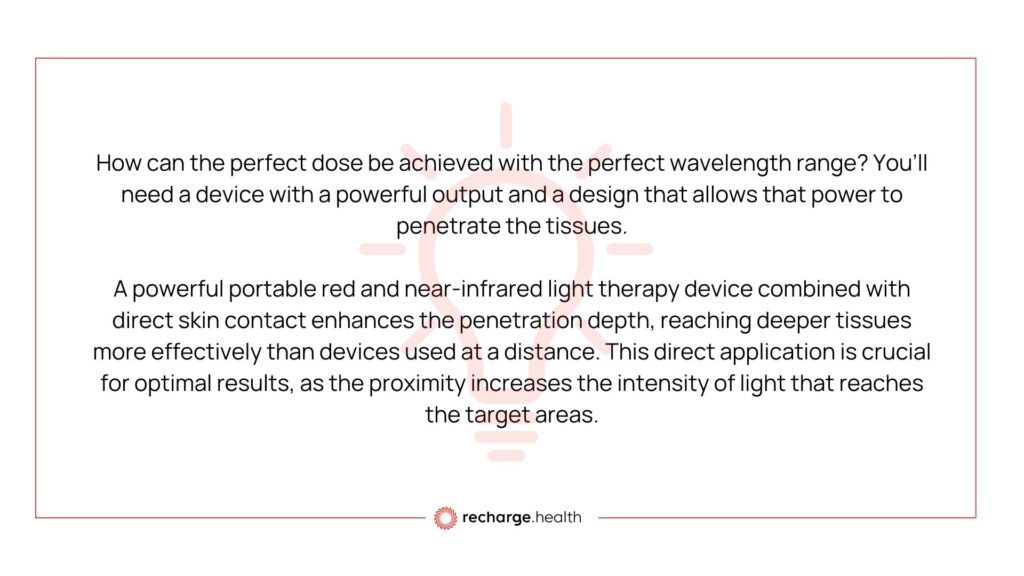
Discover the most powerful portable red light therapy device
So, we’ll begin by explaining the best wavelength ranges for different uses. Dose can be a slightly more complicated topic that we’ll explore later.
Let’s start easy:
Choosing the Right Near-Infrared and Red Light Wavelength
What to look for: When looking at your device label, this will be the value measured in nanometers (nm). You’ll find something like 630nm, 815nm, or similar. Which one is correct? That depends on what you want to achieve. The most extensive research has been conducted using devices of red and near-infrared light within the range of 600–1100nm, where red light falls between (R) 635-700nm and near-infrared (NIR) 760-1100nm. These wavelengths have been the scope of the research because they are the safest in the entire electromagnetic spectrum.
What it means: it shows you which type of red light the device uses.
Red light therapy is actually an umbrella term. It usually covers all types of therapy that use wavelengths that include visible red light, near-infrared (NIR), infrared (IR), and far-infrared (FIR) light. Each of these categories serves different healing purposes. They can penetrate skin and tissues to a different depth, so they have different effects.
| Light Name | Wavelength | Effects and Possible Uses |
|---|---|---|
| Red Light | 630-670nm | Promotes skin health Aids in wound healing Reduces inflammation Stimulates collagen production. |
| Near-Infrared Light (NIR-I) | 700-770nm | Achieves some tissue penetration Used less commonly for therapeutic purposes |
| Near-Infrared Light (NIR-II) | 800-880nm | Reaches deep tissues: muscles, nerves, and bones Aids in muscle recovery Helps with joint pain relief Improves circulation Reduces deep-tissue inflammation |
| Near-Infrared Light (NIR-III) | 900-1000nm | Ideal for treating bones, joints, and deep-muscle issues Reduces inflammation and pain in the body |
| Infrared Light | 1000-1400nm | Provides deeper tissue penetration Beneficial for deep-tissue heating and increased blood flow Less commonly used in therapeutic settings due to the potential for heat buildup* *Heat might promote inflammation, so it is not recommended for people with active inflammation issues. |
| Far-Infrared Light | 3000-10000nm (3-10 micrometers) | Enhances circulation Promotes detoxification through sweating Provides deep, soothing warmth Used in infrared saunas for relaxation, pain relief, and improving well-being Need to be used with caution as it can promote inflammation |
With this in mind, make sure that your portable red light therapy device serves the purpose you need it to. If you want a wellness or therapeutic device, look for devices that offer wavelengths in the red for superficial impact and near-infrared (NIR) for deep-in-the-body impact. Infrared (IR) also has wellness effects on overall energy, detox, and wellbeing.
Out of the entire electromagnetic spectrum, the NIR can achieve the deepest penetration. Infrared (IR) radiation is absorbed by the water in your body, so it never reaches deeper structures. NIR, on the other hand, is not affected by this absorption.
FlexBeam is a product designed after examining hundreds of studies and pinpointing the most effective wavelengths. We settled on 610-650nm (red) wavelengths and 800-850 nm (near-infrared). There are three light pods, each with two near-infrared and one red LED.
Understanding Dosing with Your Portable Red Light Therapy Device
Extensive research into scientific and clinical studies has been conducted to identify what makes red light therapy effective. This research reveals that this is not a single parameter, but a fine balance between irradiation (power density) and exposure time (dose).
Another essential aspect of choosing your correct dose is – your therapeutic goal. If you only need esthetic results that concern only the top layer of your skin – there are many devices with low power that would be just enough for you. However, for everything that involves deeper layers of your body, you need a stronger device.
Get a Powerful Portable Red Light Therapy Device
What to look for: You are looking for the measurement expressed in Watts (W). Many devices on the market have power outputs of 1W to 2W. FlexBeam offers up to 5.5W in its Program 3 setting.
What it means: Power output is directly related to the effectiveness of a red light therapy device because it determines the amount of light energy emitted by the device per unit time. In red light therapy, the therapeutic effect depends on delivering sufficient light energy to the target tissues for a specified duration. This energy stimulates various cellular processes, such as increasing ATP production, reducing inflammation, and promoting tissue repair.
However, it’s essential to consider the power output and how effectively that energy is delivered to the target tissues, which is where power density comes into play.
Ensure the Device Has an Effective Irradiance Zone
What to look for: You want your portable red light therapy device to be within the range of 20-150 mW/cm2. Also, you need your device to operate in a way that allows you to be as close as possible to the light source – ideally directly on your skin. Avoid products that do not provide this information.
What it means: Irradiance zone, irradiation, or power density – all these terms mean the same thing. It is a measurement that shows how much power is distributed around a specific area.
The strength of the light’s output, measured in mW/cm2, affects the device’s efficacy. Another essential factor is the distance from the light source. Even a seemingly minor distance can significantly reduce the irradiation. For example, a portable red light therapy device can emit 200 mW/cm2 at the source but deliver only 10 mW/cm2 just 25 cm away.
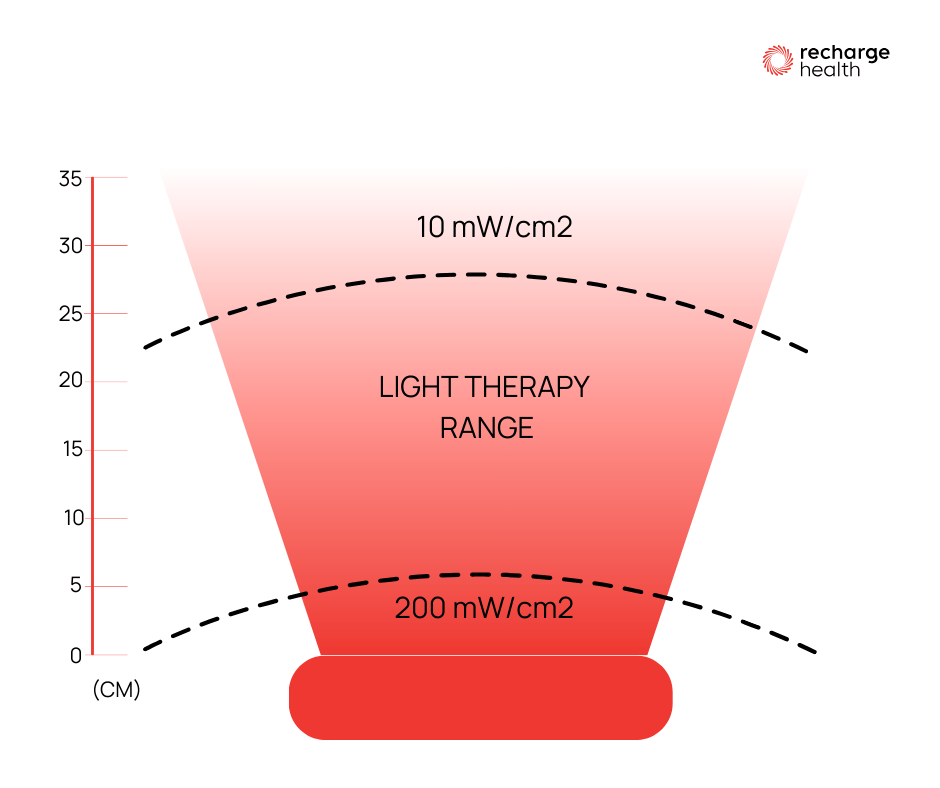
Some of the best devices, including FlexBeam, offer around 110 mW/cm2. Additionally, FlexBeam consists of LEDs and comes equipped with straps that make it easy to place directly onto your skin. This allows you to make the most of the irradiance it produces—the photons do not dissipate, and your body absorbs all the energy.
Let’s make a parallel between healthy supplements and near-infrared therapy irradiance. For example, you can say that 20 mg of coenzyme Q10 has some therapeutic effects. But if you really want efficiency and effectiveness, you will aim at 100 mg – 200 mg a day. Following the same logic, you can say that 20 mW/cm2 has some therapeutic effects. Still, if you’re really serious about using near-infrared therapy for any sort of purpose, you will aim at 100 mW/cm2. That’s why FlexBeam is tuned to these levels.
Check for Significant Energy Density
What to look for: You are looking for the measurement expressed in Joules per square centimeter (J/cm2).
What it means: The energy density expresses the total amount of energy delivered per unit area, in Joules per square centimeter (J/cm2). It is important to create energy density when you target a specific issue. Devices with high energy density, like FlexBeam with up to 89.5J/cm2, can deliver short yet potent applications. Ensure your portable red light therapy device lists its energy density, as this transparency is a sign of a trustworthy product.
A Quick Side Note: Power density and energy density sound suspiciously similar, right? However, there is a difference. Energy density is expressed in Joules per area, while power density is expressed in Watts per area. So, the difference is in Joules vs. Watts.
Watts (W) tell us how quickly energy is being used or made. Think of it as how much energy something uses in a certain amount of time. When we say something has the power of one watt, it means it uses energy at a rate of one joule per second. So, if a gadget is running on one watt, it’s using up one joule of energy every single second.
Joules (J) are what we use to measure energy itself, which you can think of as the fuel for doing stuff. It’s all about the total energy that’s either used up or created. So, when a device uses one joule of energy, it’s using a fixed amount of “fuel”, no matter how long it takes to use it up. One Joule is equivalent to one Watt per second.
Power output determines the total amount of energy emitted by the device, while power density measures the concentration of energy delivered to the target tissues. Both factors are crucial for determining the effectiveness of a red light therapy device in delivering therapeutic benefits. FlexBeam checks both of these boxes. With meticulous calculations and clever use of fans, we were able to make a device that has 3x-5x more output and density.
Hit the Sweet Spot When It Comes to Exposure Time
This brings us to exposure time, which defines how much energy the body receives during a specific time: Energy (J) = Power (W) x time (s). Exposure time is also known as fluence. Fluence must be sufficient for a successful therapy session—not too much or too little.
How do you know what’s correct for you? There’s no easy way to say it – you don’t. This is something that an expert needs to calculate for you and make sure you are getting what you need.
Therefore, this one is a little bit about trust. You need to find a portable red light therapy device manufactured with the user in mind, offers good support, and has real experts on staff.
FlexBeam is specifically designed to deliver the precise dose at the correct penetration depth. Each dose was calculated according to robust scientific research, so you do not need to calculate irradiation, fluence, or power density.
Dr. Zulia Frost is constantly working on fine-tuning the use of FlexBeam and the dosage. She is in close contact with many of our thousands of customers, looking into the effectiveness of our portable device. Of course, there is a pre-programmed dosage and timing.
FlexBeam is designed to deliver dosage in one cycle, which is never harmful and is always beneficial. You can only make it more effective by following different Placement Guidelines that Recharge Health offers as a part of our free membership program.
Safety and Convenience Factors
We said it before, and we’ll say it again—the best near-infrared and red light therapy is actually the one that you use constantly. That’s definitely not going to happen if you worry that your portable red light therapy device is not safe or if it is just too complicated to use. You need a device that fits into your busy lifestyle—something that fits into your backpack and goes with you on travel, to work, etc.
Red light therapy is 100% safe. It should never burn your skin, emit UV rays, or cause other issues. However, caution is needed in situations like pregnancy, active malignant conditions, eye exposure, and similar.
However, FlexBeam is super convenient and easy to use when following instructions.
Minimize Exposure to nnEMF
Non-native electromagnetic fields (nnEMF) can have negative health effects, potentially undermining the benefits of red light therapy. A portable red light therapy device that operates on battery power is preferable, as it significantly reduces exposure to nnEMF and is safer for regular use.
Before releasing FlexBeam and making it readily available to the general public, we tested its nnEMF radiation. Our measuring instruments have caught more EMF from a local mobile phone tower than the FlexBeam being measured, which speaks volumes about its safety.
Convenience
A major advantage of portable red light therapy devices, such as FlexBeam, is their ease of use. These devices offer the flexibility to receive treatment anywhere, without the need for cumbersome setups like standing in front of a panel. Their design allows for wrapping around targeted areas, enabling you to continue with your daily activities while receiving therapy.
All these factors are essential when choosing your portable red light therapy device. Now, let’s look into what’s available for you on the market, today.
Exploring Different Types of Portable Red Light Therapy Devices
Different types of red light therapy devices today cover one or more of the essential factors to consider when choosing a portable red light therapy device.
Wearable Devices: FlexBeam belongs to the group of wearable, portable red light therapy devices. It is the result of efforts to pack the healing power of large red light therapy panels into a portable device. And it has been a huge success. FlexBeam doesn’t fall behind when it comes to irradiation, energy density, and dose delivery. Moreover, it offers both targeted and systemic effects of near-infrared and red light therapy.
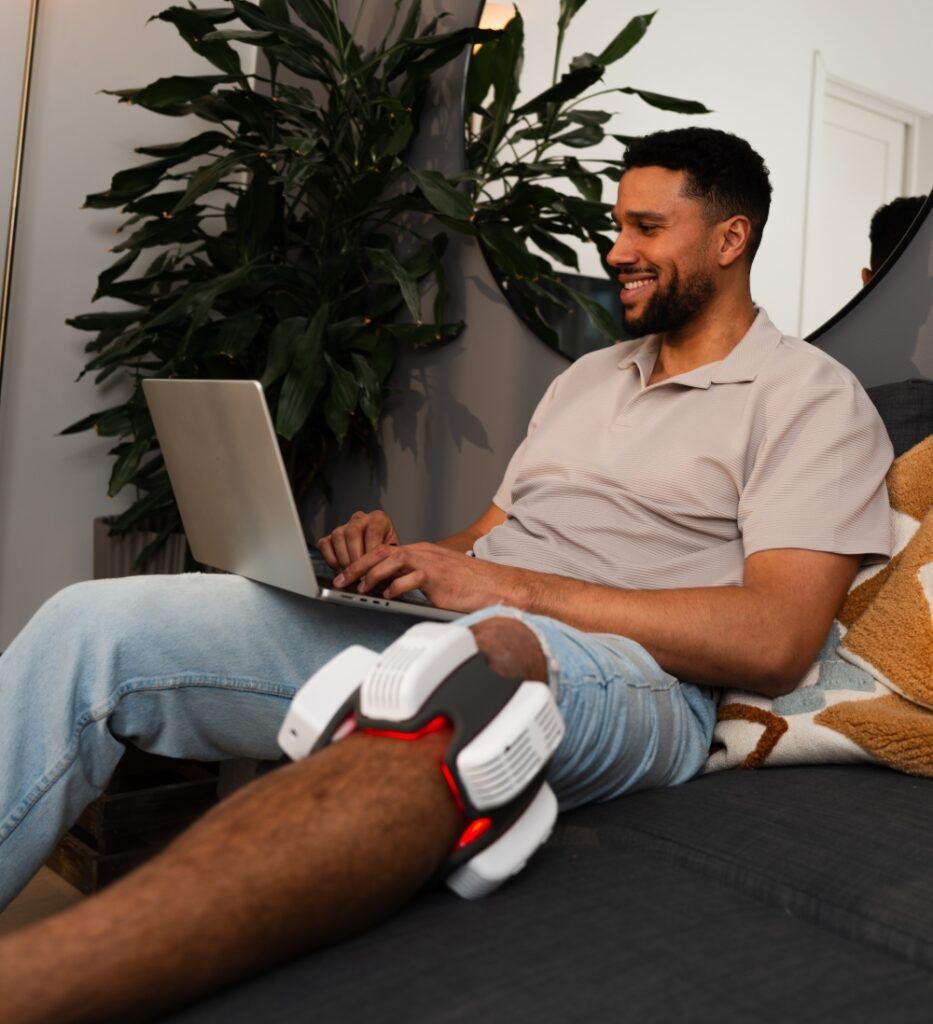
Handheld LED Devices: These are small, handheld gadgets that emit red and near-infrared light. They’re versatile and can be used on various body parts, including joints, muscles, and areas needing pain relief or healing. Make sure they offer the irradiance and dosage that you need to achieve your goals. The downside of such a portable red light therapy device is is that you still need to hold them, so even though they are portable, they somewhat lack convenience.
Red Light Therapy Pads and Mats: Flexible and portable, these pads can be wrapped around limbs or other parts of the body for targeted treatment. Mats can be used for a variation of full-body red light therapy or targeted use. Some LED-driven devices are very weak, others have an array of weak but multiple LEDs. Collectively, power could be high, but it is distributed over a large area making power density insufficient compared to targeted, high-power density of FlexBeam, which guarantees photonic energy delivery deep into the tissue. When choosing such a device, make sure that these LEDs can provide you with enough power and energy necessary for proper treatment.
Desk Lamps, Floor Stands and Portable Panels: Some portable red light therapy devices are designed to sit on a desk or stand on the floor but are lightweight and easy to move. These are suitable for people who want to integrate red light therapy into their daily routines, like during work or relaxation at home. It is essential to know whether you are using the energy output of these devices effectively. In many cases protective goggles are necessary when using these devices. Given that you’d have to use them at a distance, and probably over your clothing, it is important to determine how much of their healing power actually reaches you.
Red Light Therapy Masks: These devices are usually designed for skin care and rejuvenation purposes. Their effects are cosmetic and they are not used for health optimization and wellness.
Portable vs Full-Body Red Light Therapy
With all this talk about power and energy, there is a logical question that begs for an answer – why not use a full body red light therapy device?
The short answer is – there’s no need.
If your portable red light therapy device offers enough power and dosage, you are not gaining anything by using a larger device.
If you are concerned that a portable device won’t give you systemic effects, you shouldn’t worry. When positioned carefully and used properly, a portable device can have just the same effects as wall panels. For example, positioning your FlexBeam on the areas of your body that contain major arteries or main nerve clusters mean that they will disperse the energy received from your powerful portable red light therapy device.
Moreover, FlexBeam can reach certain areas that a large panel simply can’t.
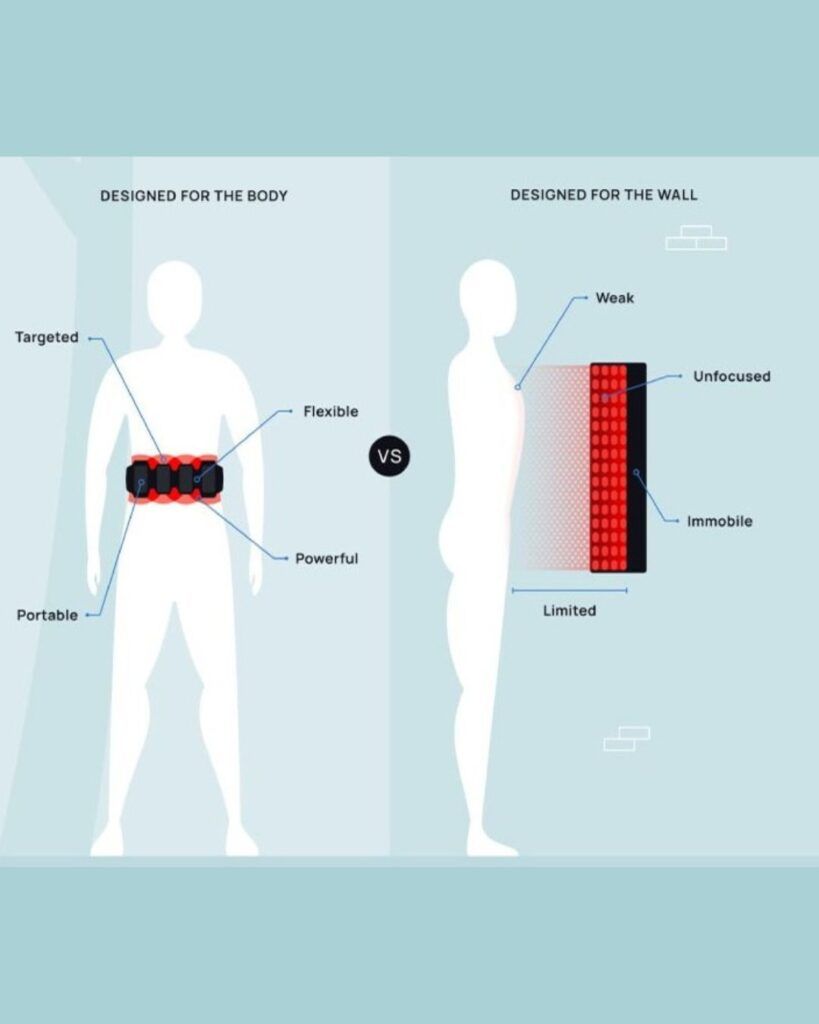
For example, let’s say you are using a near-infrared and red light therapy device to treat a knee injury. A panel cannot deliver the light to all sides of your knee at the same time. Also, you would have to stay at a certain distance from it, and that reduces its effectiveness. On the other hand, wrapping the FlexBeam around your knee means that the correct dosage of light will be delivered where it’s needed at all times.
What Makes FlexBeam the Best Portable Red Light Therapy Device
Yes, this is a very bold claim to make, but it is not a claim that is made lightly. When the medical and science experts in Recharge Health designed FlexBeam, it was not because there were no near-infrared and red light therapy devices on the market. On the contrary, red light panels, wraps, belts, mats, and other devices were already there. However, this group of people still decided to make something new.
Why?
Because they believed that they could do it better. This belief was not based on guesses. It was based on hundreds of hours of research, exploration, and experimentation. Recharge Health made FlexBeam because we believe this is the best portable red light therapy device.
Here’s why.
In short – amazing power output in combination with intelligent design for the best possible results.
Let’s explain this in more detail. Power output is the energy emitted by a device. Higher power output means the potential for more energy. We equipped FlexBeam with 3-5x more power than any other portable device on the market. However, that alone doesn’t have to mean it’s better.
What actually matters from the therapeutic perspective is – power density or irradiance. High power density means that more energy is being concentrated in a smaller area, which is essential for deeper penetration.
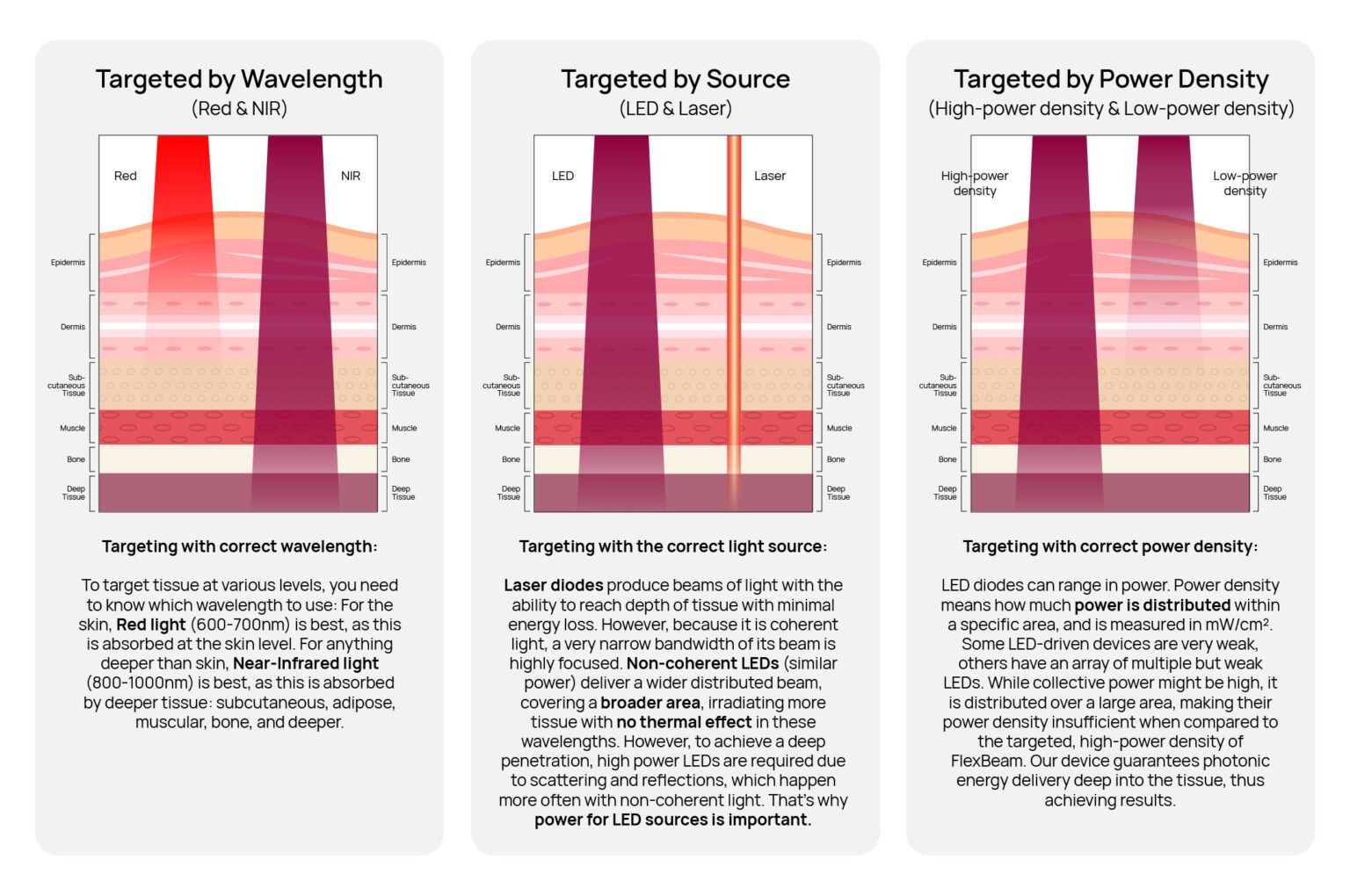
The connection between power output and power density is direct: a device’s power output affects how densely the energy can be packed into the light that reaches the skin or tissue. For example, when applied directly to the skin, a high-power output device can maintain a high power density even if the light covers a small area.
This is essential in portable red light therapy devices like FlexBeam, where the aim is to deliver intense light directly to the areas that need treatment without spreading the energy too thin, which would reduce effectiveness.
You may ask – OK, but can a device with a lesser power output deliver more irradiance than a stronger one? Theoretically, yes, but this is where it really gets interesting.
You can achieve more irradiance from your power output in three ways:
Focusing of the light: Devices can focus light into a more concentrated area. If a device with a lower total power output efficiently focuses its light into a smaller area (like a FlexBeam), it can achieve higher power density than a device with a higher power output that spreads its light over a larger area (like a panel).
Distance from the light source: The distance between the light source and the target area also affects irradiance. Light intensity decreases with distance due to the spread of light rays. A device with a lower power output placed closer to the skin can achieve higher irradiance compared to a higher power device that must be used at a greater distance. Now remember – FlexBeam goes directly to the skin AND has powerful output.
Design and efficiency of LEDs: The design and efficiency of the light-emitting diodes (LEDs) used can also influence the irradiance. High-efficiency LEDs can produce more light per unit of power consumed, which means a device with less electrical power input could still deliver high light output if it uses very efficient LEDs.
So, not only does FlexBeam have a stronger power output, but it also boasts a design that makes absolutely the most out of it. Honestly, there’s no other portable red light therapy on the market that covers both sides.
If you ask us and our team of medical and science experts, the verdict is clear: If you are looking for a wellness and health optimization tool that can help you with a wide array of medical issues, FlexBeam is the most powerful portable red light therapy device on the market today.
However, we strongly encourage you to make an informed decision before choosing your device. Use this guide to help you understand the labels and know what to look for when choosing your portable red light therapy device.
Sources
- Hamblin MR. Mechanisms and applications of the anti-inflammatory effects of photobiomodulation. AIMS Biophys. 2017;4(3):337-361. PMCID: PMC5523874 DOI: 10.3934/biophy.2017.3.337
- Chung H, Dai T, Sharma SK, Huang YY, Carroll JD, Hamblin MR. The nuts and bolts of low-level laser (light) therapy. Ann Biomed Eng. 2012 Feb;40(2):516-33. PMID: 22045511.
- Ronnie L. Yeager, Deanna A. Oleske, Ruth A. Sanders, John B. Watkins, Janis T. Eells, Diane S. Henshel. Melatonin as a principal component of red-light therapy. Medical Hypotheses. Volume 69, Issue 2, 2007. Pages 372-376, ISSN 0306-9877, PMID: 17321060, DOI: 10.1016/j.mehy.2006.12.041
- DeSmet KD, Paz D, Corry JJ, et al. Clinical and experimental applications of NIR-LED photobiomodulation. Photomedicine and Laser Surgery. 2006;24(2):121-128. doi:10.1089/pho.2006.24.121
- Crna WJK DC. Immune-modulating Effects of Therapeutic Laser. Med Central. https://www.medcentral.com/pain/chronic/immune-modulating-effects-therapeutic-laser. Published March 7, 2011.
- Hipskind SG, Grover F, Fort TR, et al. Pulsed Transcranial Red/Near-Infrared Light Therapy Using Light-Emitting Diodes Improves Cerebral Blood Flow and Cognitive Function in Veterans with Chronic Traumatic Brain Injury: A Case Series. Photomedicine and Laser Surgery. Published online November 28, 2018. doi:10.1089/pho.2018.4489
- Hashmi, Javad T et al. “Effect of pulsing in low-level light therapy.” Lasers in surgery and medicine vol. 42,6 (2010): 450-66. doi:10.1002/lsm.20950
